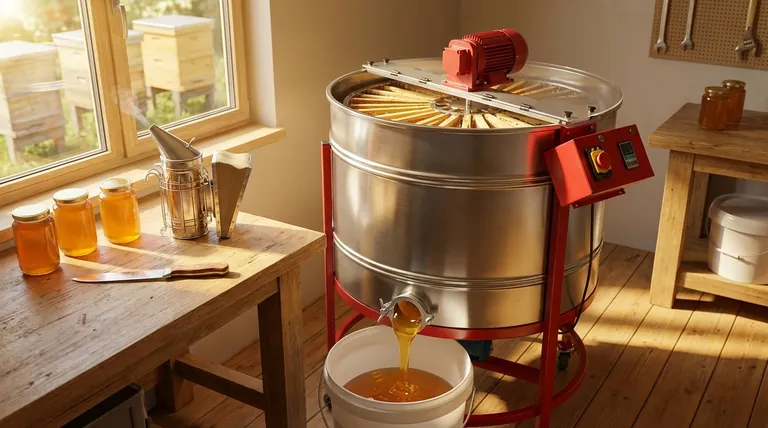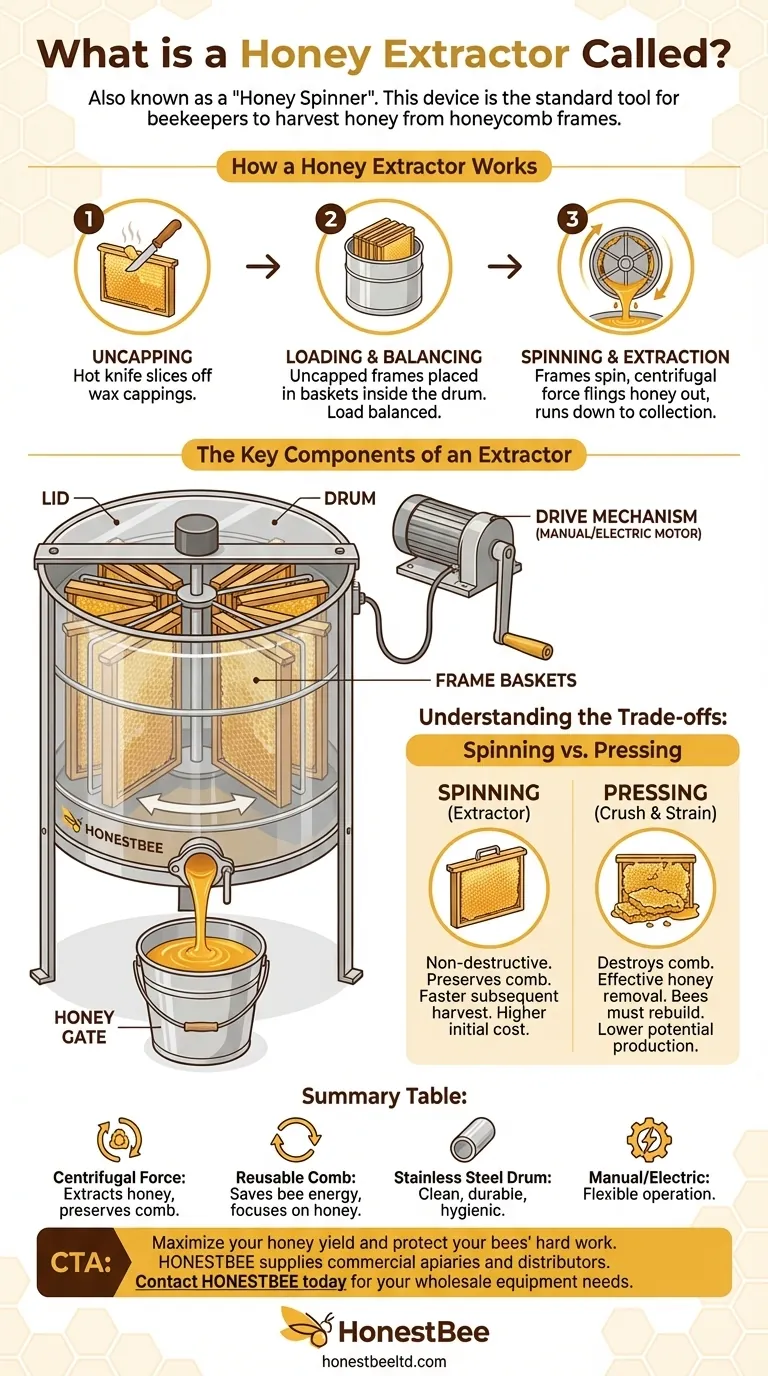The device is called a honey extractor. This machine is the standard tool used by beekeepers to harvest honey from honeycomb frames. While "honey extractor" is the correct technical term, it is also sometimes referred to as a "honey spinner" because of the way it functions.
A honey extractor is a mechanical device that uses centrifugal force to remove honey from the comb. Its primary advantage is that it performs this task without destroying the delicate wax structure, allowing the bees to reuse the comb immediately.

How a Honey Extractor Works
A honey extractor's design is centered around a simple, powerful physical principle. Understanding this process reveals why it is an indispensable tool for modern beekeeping.
The Principle of Centrifugal Force
The core of the process is centrifugal force. By spinning the honeycomb frames at a high speed, the dense honey is flung outward against the wall of the extractor's drum, leaving the lighter wax comb intact.
The Step-by-Step Process
First, the beekeeper uses a hot knife to gently slice off the thin wax cappings that bees use to seal the honey in each cell.
Next, these uncapped frames are placed into baskets inside the extractor's drum. It's critical to balance the load by placing frames of similar weight opposite each other to prevent the machine from vibrating violently.
The beekeeper then spins the frames, either with a manual crank or an electric motor. The honey flies out of the cells, runs down the inner wall of the drum, and collects at the bottom.
The Importance of Preserving the Comb
The most significant benefit of this method is the preservation of the comb. Bees expend a tremendous amount of energy to produce wax and build these intricate structures.
By returning the empty, intact combs to the hive, beekeepers give the colony a massive head start. The bees can immediately begin refilling the cells with honey instead of spending weeks rebuilding the comb from scratch.
The Key Components of an Extractor
While designs vary, all honey extractors share a few fundamental parts that work together to harvest honey efficiently.
The Drum and Lid
The drum, or barrel, is the large stainless steel cylinder that contains the entire operation. A lid covers the top to prevent honey from splattering out while the machine is spinning.
Frame Baskets
Inside the drum is a rotating assembly with baskets or holders. These are designed to securely hold the honeycomb frames in place as they spin.
The Drive Mechanism
The spinning action is powered by either a manual hand crank or an electric motor. Electric models often include speed controls for more precise operation.
The Honey Gate
At the very bottom of the drum is a honey gate, which is essentially a spigot or valve. Once the honey has pooled at the bottom, this gate is opened to drain the pure, filtered honey into buckets or other containers.
Understanding the Trade-offs
Using a honey extractor is the dominant method, but it is not the only one. Understanding the alternative highlights the specific advantages of centrifugal extraction.
Extraction by Spinning
The primary benefit is that this method is non-destructive. The comb is a valuable asset in the hive, and preserving it allows for a faster and larger subsequent honey harvest. The main drawback is the initial cost of the equipment.
Extraction by Pressing
An older method involves using a honey press to crush the comb and squeeze the honey out. This technique is effective at removing honey but completely destroys the comb in the process.
This forces the bee colony to expend significant resources and time rebuilding, which ultimately reduces their potential for honey production.
Making the Right Choice for the Goal
The method you choose for honey extraction directly impacts the efficiency and sustainability of your beekeeping.
- If your primary focus is sustainable beekeeping and maximizing honey yield: A honey extractor is the essential and correct tool, as it preserves the bees' comb for reuse.
- If your primary focus is a one-time harvest without concern for the comb: The crush and strain (or pressing) method can work, but it comes at a high energy cost to the bee colony.
Ultimately, using a honey extractor respects the immense work of the bees and enables a more productive partnership between the beekeeper and the hive.
Summary Table:
| Feature | Benefit |
|---|---|
| Centrifugal Force | Extracts honey efficiently while preserving the wax comb. |
| Reusable Comb | Saves bees energy, allowing them to focus on honey production. |
| Stainless Steel Drum | Ensures a clean, durable, and hygienic harvesting process. |
| Manual/Electric Operation | Offers flexibility for beekeepers of all operation sizes. |
Maximize your honey yield and protect your bees' hard work.
A high-quality honey extractor is an investment in the sustainability and profitability of your apiary. HONESTBEE supplies commercial apiaries and beekeeping equipment distributors with durable, efficient honey extractors and other essential beekeeping supplies through our wholesale-focused operations.
Contact HONESTBEE today to discuss your equipment needs and discover how our products can support your success.
Visual Guide

Related Products
- HONESTBEE 72 Frame Industrial Electric Honey Extractor for Beekeeping
- 2 Frame Stainless Steel Manual Honey Spinner Extractor for Beekeeping
- HONESTBEE 3-Frame Manual Acrylic Honey Extractor
- 40 Frame Commercial Electric Honey Extractor for Beekeeping
- electric honey extractor honey centrifuge 3 frame honey extractor stainless steel honey frame extractor
People Also Ask
- How is honey harvested from Langstroth hives? A Guide to Efficient, Comb-Preserving Extraction
- What are the two common types of honey extractors? Choose the Right Extractor for Your Apiary
- What is the energy consumption like for automatic honey extractors? Maximize Your Harvest Efficiency
- What are the advantages of automated honey extractors in terms of time efficiency? Boost Your Harvest Speed
- How do automatic honey extractors function? Achieve High-Efficiency Honey Harvesting



















